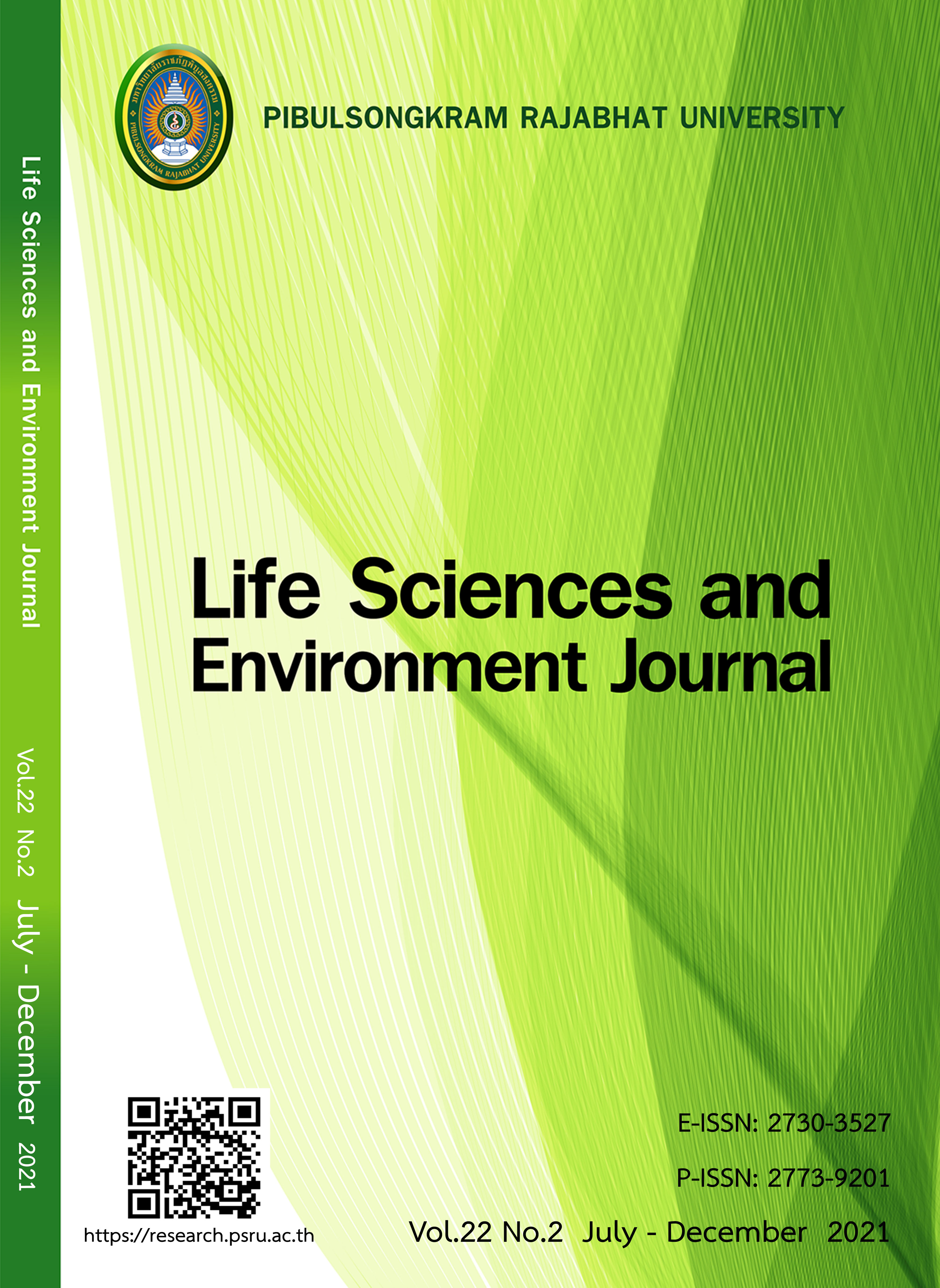APPLICATION OF THE PIGMENT OF ACTINOBACTERIA ISOLATED FROM THE WASPS-NEST SOIL FOR DYEING SILK FIBERS
DOI:
https://doi.org/10.14456/lsej.2021.4Keywords:
Pigment, Actinobacteria, Silk fibers dyeing, Wash fastness, Light FastnessAbstract
Actinobacteria-derived pigments are the emerging class of natural dyes, which have attracted significant attention for the development of novel natural pigments for fiber dyeing. This research aims to isolate actinobacteria from wasps-nest soil for dye production, silk fibers dyeing, examine the qualities of fibers dyed by pigments and identify actinobacteria species. The results showed that 10 isolates of actinobacteria could be isolated from wasps-nest soil using Sodium Caseinate Agar (SCA). Moreover, the obtained actinobacteria J10 exhibited the yellow color and show the best dyeing on silk fibers. To investigate the qualities of pigment, the textile characteristics of dyed silk fibers were analyzed with the color fastness to washing and light by following the standard methods namely ISO105-C06:2010(E) and ISO 105-B02:2014(E), respectively. The result showed that the fastness to washing was ranged in the 4 to 5 level, which referred to a very good acceptance level. However, the light fastness was observed in the 3 to 4 level, which referred to an intermediate acceptance. The identification of actinobacteria isolate J10 based on comparative sequence analysis of 16S rDNA gene revealed the similarity to Streptomyces costaricanus (99.57%), S. prasinopilosus (99.50%), S. rochei (99.50%), S. padanus (99.50%), and S. griseofuscus (99.50%). These actinobacteria were reported as Streptomyces spp. which could produce the secondary metabolites to apply for medical, agricultural and commercial purposes. Hence, the pigment could be potential candidates to further develop for textile dying applications.
References
Chakraborty I, Redkar P, Munjal, M. et al. Isolation and characterization of pigment producing marine actinobacteria from mangrove soil and applications of bio-pigments. Der Pharmacia Lettre 2015;7,93-100.
Felsenstein J. Confidence limits on phylogenies: An approach using the bootstrap. Evolution 1985;39: 783-791.
Goodfellow M, Kämpfer P, Busse HJ. et al. Bergey’s Manual of Systematic Bacteriology. 2nd Edition. Volume Five. The Actinobacteria, Part A and B. New York: Springer-Verlag; 2012.
Kermeoglu F, Aksoy U, Kalender A. et al. Determination of the Minimum Inhibitory Concentrations of Alexidine and Chlorhexidine Against Enterococcus faecalis and Candida albicans: An In Vitro Study. The Cureus Journal of Medical Science 2018;10(2):1-8.
Kim HR, & Song HG. Antifungal activity of Streptomyces costaricanus HR391against some plant-pathogenic fungi. Korean Journal of Microbiology 2016;52(4):437-443.
Kramar A, Ilic-Tomic T, Petkovic M. et al. Crude bacterial extracts of two new Streptomyces sp. isolates as bio-colorants for textile dyeing. World Journal Microbiology Biotechnology 2014;30: 2231-2240.
Kulkarni VM, Gangawane PD, Patwardhan AV, & Adivarekar RV. Dyeing of silk/wool using crude pigment
extract from an isolate Kocuria flava sp. HO-9041. Octa Journal of Environmental Research 2014;2(4).
Kumar S, Stecher G, Li M, Knyaz C. MEGA X: Molecular Evolutionary Genetics Analysis across computing platforms. Molecular Biology and Evolution 2018;35:1547-1549.
Li S, Ji J, Hu S. et al. Enhancement of ε-poly-L-lysine production in Streptomyces griseofuscus by addition of exogenous astaxanthin. Bioprocess and Biosystems Engineering 2020;43:1813-1821.
Lim TH, Kwon SY, Kim JH. Effects of Streptomyces griseofuscus 200401 on growth of pepper plants and Phytophthora blight by Phytophthora capsici. Research in Plant Disease 2006;12(1):46-50.
Liu M, Jia Y, Xie Y. et al. Identification of the actinomycin D biosynthetic pathway from marine-derived Streptomyces costaricanus SCSIO S0073. Marine drugs 2019;17(4):240.
Maiti PK, Mandal S. Lentzea indica sp. nov., a novel actinobacteria isolated from Indian Himalayan-
soil. Antonie van Leeuwenhoek 2020;113(10):1411-1423.
Mansour HF, Heffernan S. Environmental aspects on dyeing silk fabric with stictacoronata lichen using ultrasonic energy and mild mordants. Clean Technologies and Environmental Policy 2010; 13:207–213.
Mullis K, Faloona F, Scharf S. et al. Specific Enzymatic Amplification of DNA In Vitro: The Polymerase Chain Reaction. Cold Spring Harb Symp Quant Biol 1986;51(1):263-73.
Priyadharsini P, Dhanasekaran D. Diversity of soil allelopathic Actinobacteria in Tiruchirappalli district,
Tamilnadu, India. Journal of the Saudi Society of Agricultural Sciences 2015;14(1),54-60.
Reddy GS, Potrafka RM, Garcia-Pichel F. Modestobacter versicolor sp. nov., an actinobacterium from biological soil crusts that produces melanins under oligotrophy, with emended descriptions of the genus Modestobacter and Modestobacter multiseptatus Mevs et al. 2000. International Journal of Systematic And Evolutionary Microbiology 2007;57(9),2014-2020.
Saitou N, Nei M. The neighbor-joining method: A new method for reconstructing phylogenetic trees. Molecular Biology and Evolution 1987;4:406-425.
Shirata A, Takanori T, Hiroe Y. et al. Atsushi K and Hiroshi K. Isolation of bacteria producing bluish-purple pigment and use for dyeing. Japan Agricultural Research Quarterly. 2000;34:131-140.
Sipriyadi S, Wahyudi AT, Suhartono MT. et al. Optimization of Xylanase Production by Streptomyces costaricanus 45I-3 Using Various Substrates through Submerged Fermentation. Microbiology Indonesia 2020;14(1):5-5.
Sundström E. What is a "Mordant" and why use them? International Mushroom Dye Institute. 2004. Available at: http://sonic.net/dbeebee/IMDI_new/mordants.html#Contact%20us. Accessed March 27, 2021.
Suomi P. All Fiber Arts. Fungi dye recipe. Pisolithusarhizus - Herne Kuukunen (FI). 2001. Available at: https://www.allfiberarts.com/2017/fungi-dye-pisolithus-arhizus.htm. Accessed March 20, 2021.
Tajima F and Nei M. Estimation of evolutionary distance between nucleotide sequences. Molecular Biology and Evolution 1984;1:269-285.
Thurnkul N, Huanraluek N. Isolation of actinomycetes from termite mound in Srisatchanalai district Sukhothai province for silk fiber dyeing. PSRU Journal of Science and Technology 2017;2(3):1-8.
Vaidyanathan J, Bhathena-Langdana Z, Adivarekar RV. Production, Partial Characterization, and Use of a Red Biochrome Produced by Serratia sakuensis subsp. Nov Strain KRED for Dyeing Natural Fibers. Biotechnology and Applied Biochemistry 2012;166(2):321-335.
Velmurugan P, Kim MJ, Park JS. et al. Dyeing of cotton yarn with five water soluble fungal pigments obtained from five fungi. Fibers and Polymers 2010;11(4):598-605.
Downloads
Published
How to Cite
Issue
Section
License
Each article is copyrighted © by its author(s) and is published under license from the author(s).










